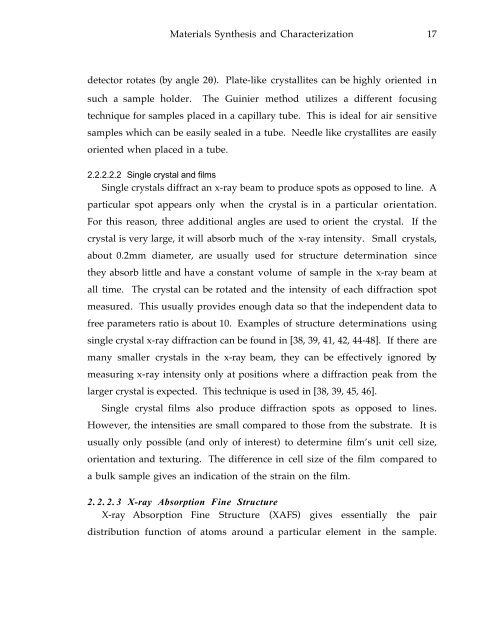MAGNETISM ELECTRON TRANSPORT MAGNETORESISTIVE LANTHANUM CALCIUM MANGANITE
MAGNETISM ELECTRON TRANSPORT MAGNETORESISTIVE LANTHANUM CALCIUM MANGANITE
MAGNETISM ELECTRON TRANSPORT MAGNETORESISTIVE LANTHANUM CALCIUM MANGANITE
You also want an ePaper? Increase the reach of your titles
YUMPU automatically turns print PDFs into web optimized ePapers that Google loves.
Materials Synthesis and Characterization 17<br />
detector rotates (by angle 2θ). Plate-like crystallites can be highly oriented in<br />
such a sample holder. The Guinier method utilizes a different focusing<br />
technique for samples placed in a capillary tube. This is ideal for air sensitive<br />
samples which can be easily sealed in a tube. Needle like crystallites are easily<br />
oriented when placed in a tube.<br />
2.2.2.2.2 Single crystal and films<br />
Single crystals diffract an x-ray beam to produce spots as opposed to line. A<br />
particular spot appears only when the crystal is in a particular orientation.<br />
For this reason, three additional angles are used to orient the crystal. If the<br />
crystal is very large, it will absorb much of the x-ray intensity. Small crystals,<br />
about 0.2mm diameter, are usually used for structure determination since<br />
they absorb little and have a constant volume of sample in the x-ray beam at<br />
all time. The crystal can be rotated and the intensity of each diffraction spot<br />
measured. This usually provides enough data so that the independent data to<br />
free parameters ratio is about 10. Examples of structure determinations using<br />
single crystal x-ray diffraction can be found in [38, 39, 41, 42, 44-48]. If there are<br />
many smaller crystals in the x-ray beam, they can be effectively ignored by<br />
measuring x-ray intensity only at positions where a diffraction peak from the<br />
larger crystal is expected. This technique is used in [38, 39, 45, 46].<br />
Single crystal films also produce diffraction spots as opposed to lines.<br />
However, the intensities are small compared to those from the substrate. It is<br />
usually only possible (and only of interest) to determine filmÕs unit cell size,<br />
orientation and texturing. The difference in cell size of the film compared to<br />
a bulk sample gives an indication of the strain on the film.<br />
2. 2. 2. 3 X-ray Absorption Fine Structure<br />
X-ray Absorption Fine Structure (XAFS) gives essentially the pair<br />
distribution function of atoms around a particular element in the sample.
















